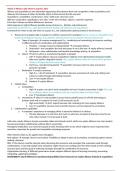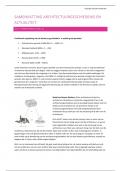Article 1 When to ally when to acquire, Dyer
Alliance and acquisition as two alternative approaches that deserve their own recognition. Many acquisitions and
alliances fail, because of failure to identify which of the two best fits the scenario.
Acquisitions: competitive, market price, risky / build scale, decrease costs
Alliance: cooperative, negotiations, less risky / enter new markets, regions, customer segments
Firms don’t always see these differences, because:
Initial experience might influence possible wrong choices (i.e., blinders and preferences)
Organisational barriers (i.e., split departments for dealing with alliances and acquisitions)
Framework for when to ally and when to acquire (i.e., the collaboration options) based on three factors:
1. Resources & synergies (ally or acquire to combine resources for synergies (human resources; intangibles (e.g.
brand) technological resources (e.g. patents); physical resources (e.g. plants); financial resources)
a. Types of synergies resource management (i.e., combining and customizing of resources resulting
in different levels of coordination and collaboration)
i. Modular = manage resources independently nonequity alliance
ii. Sequential = one completes the task and passes it on to the next equity alliance (control)
iii. Reciprocal = close collaboration and iterative knowledge-sharing acquisition
b. Nature hard vs soft (e.g. manufacturing plants vs people)
i. Soft equity alliance, because acquisitions might be more detrimental (viewed as hostile
take-over, layoffs, integration issues). Also, equity alliances allow for control of the partner’s
actions and aligns interests more closely
ii. Hard (e.g., manufacturing plants) acquisition, because easier to value and easy to
generate synergies
c. Redundant surplus resources
i. High (i.e., a lot of redundant acquisition, because economies of scale and cutting costs
easier to realise through eliminating resources
ii. Low non-equity alliance
iii. Medium equity alliance
2. Market place
a. Competition
i. High acquire, you don’t want competition to have it (unless uncertainty is high! Then opt
for an alliance where it is possible to pick up a majority stake at a future date)
ii. Low (non)equity alliance
b. Uncertainty when it is not possible to assess future payoffs (asses 1) will the technology or
product work and is it superior to rivals 2) will consumer use it)
i. High uncertainty don’t acquire because risk, instead go for (non-)equity alliance
ii. Low acquisition, because now invested resources are less exposed to uncertainty
3. Collaboration capabilities
a. A company’s experience in managing either is bound to influence its choices
i. The key takeaway is to not focus too much on what you are good at (hammers tend to see
only nails). Instead, try to be good at both.
(side note: equity alliances involve ownership stakes and shared control, while non-equity alliances are more project-
focused and involve collaboration without direct ownership)
Managerial implication: you need to be good at both; knowing when to use which might be more important than
execution; important for growth and competitive advantage purposes
Other theories that can be applied (own thoughts):
Real options strategic choices and analysis. Flexibility to adapt in times of uncertainty. Considering options before
making a decision.
RBV this theory could be relevant when discussing the resources and synergies that companies seek through
collaborations. It can help explain why companies might choose one strategy over the other based on their existing
resource base and their goal of achieving synergies through the combination of resources.
Organisation learning different governance modes support different types of learning (accessing, processing,
integrating, applying knowledge).
DIGESTIBILITY (stark differences manufacturing facilities (hard resources) so maybe alliance instead of acquisition)
, Article 2 Signalling why and where, Aalbers & McCarthy
Signalling theory: using signals (this can be done strategically / intentionally) to convey information. This information
facilitates decision-making for the receivers. In this article, the acquisition motive (why; purpose) and the relatedness
of the acquirer and the acquired (where; context) act as signals for investors and shape market reactions (all about
risk; the lower the risk the better the market reacts).
Exploitation > exploration
Pure (explore or exploit) > ambidextrous (combination of the two).
Balanced ambidextrous > positive latent mechanism (ambidextrous and focus on exploitation) > negative latent
mechanism (ambidextrous and focus on exploration) (positive>negative, because purpose is clearer)
These motives vary in their degree of risk. Receivers perceive and evaluate this potential risk (signal) and this is then
incorporated in the market price. Therefore, investors are actively seeking for signals.
Exploitation
Refining / improving efficiency / focus on current ways of doing things
Short-term; less risky; predictable; easier to estimate synergy
Building economies of scale; cutting costs etc.
Exploration
Experimentation / risk taking / innovation
Long-term; more risky; less predictable; harder to estimate synergy
Expanding into new products, markets, services
Ambidextrous
Combines the two
Risky, because it requires managing two contradictory aspects ( complex strain lower performance)
Relatedness (moderator only for H2)
Greater relatedness makes synergy evaluation/realization and integration easier (so it is less risky and offers
higher returns)
Pre-deal: familiarity, less information asymmetry; less uncertainty; better evaluation less risk
Post-deal: better synergy realization & better integration less risk
Dependent variable: market reactions (cumulative abnormal returns (CARs), based on stocks of the acquiring firm)
Exploitative motives are lower risk and offer higher returns, because synergy evaluation/realization and integration
are easier. So, markets react better to these pure exploitative motive acquisitions (risk market reaction)
Three hypotheses:
1. Exploitation > exploration (exploitation more positive market reaction)
2. U-shape relationship for the ambidextrous situation (too much focus on of the two will result in a more
negative market reaction)
3. Relatedness (where) flattens this u-shape (relatedness is less risky; so more tolerant towards the negative
latent mechanism and I think also for ambidexterity in general)
Managerial implication: awareness of signalling (possibly to influence the market reactions, which can affect your
stock price and performance); awareness of what might drive market reactions, which allows you to decide on the
most optimal acquisition motive and also context (so relatedness)
Other theories that can be applied (own thoughts):
RBV acquiring resources and capabilities (through exploration or exploitation) is relevant to resource-based view
theory. Acquisitions are often driven by the desire to acquire valuable resources, and the theory can be applied to
understand why some acquisitions are preferred over others.
Behaviour Theory acquisition announcements as behavioural triggers that influence market responses. Why and
where influences investor behaviour; also, maybe the investors are biased and only go for pure exploitative
acquisitions in related firms even though this might not be a good idea given other possibilities







